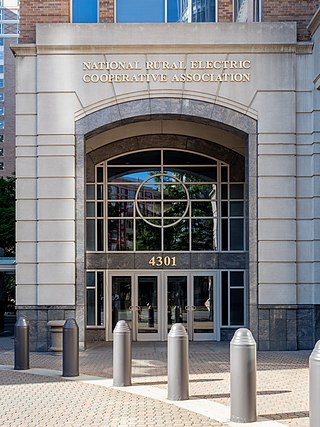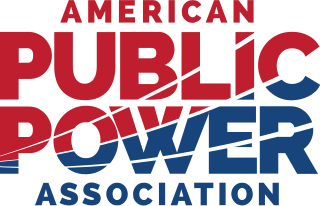Related Research Articles
Southern Company is an American gas and electric utility holding company based in the Southern United States. It is headquartered in Atlanta, Georgia, with executive offices also located in Birmingham, Alabama. The company is the second largest utility company in the U.S. in terms of customer base, as of 2021. Through its subsidiaries it serves 9 million gas and electric utility customers in 6 states. Southern Company's regulated regional electric utilities serve a 120,000-square-mile (310,000 km2) territory with 27,000 miles (43,000 km) of distribution lines.

Power-line communication (PLC) is the carrying of data on a conductor that is also used simultaneously for AC electric power transmission or electric power distribution to consumers. The line that does so is known as a power-line carrier.

Automatic meter reading (AMR) is the technology of automatically collecting consumption, diagnostic, and status data from water meter or energy metering devices and transferring that data to a central database for billing, troubleshooting, and analyzing. This technology mainly saves utility providers the expense of periodic trips to each physical location to read a meter. Another advantage is that billing can be based on near real-time consumption rather than on estimates based on past or predicted consumption. This timely information coupled with analysis can help both utility providers and customers better control the use and production of electric energy, gas usage, or water consumption.
A utility cooperative is a type of cooperative that is tasked with the delivery of a public utility such as electricity, water or telecommunications to its members. Profits are either reinvested for infrastructure or distributed to members in the form of "patronage" or "capital credits", which are dividends paid on a member's investment in the cooperative.
Broadband over power lines (BPL) is a method of power-line communication (PLC) that allows relatively high-speed digital data transmission over public electric power distribution wiring. BPL uses higher frequencies, a wider frequency range, and different technologies compared to other forms of power-line communications to provide high-rate communication over longer distances. BPL uses frequencies that are part of the radio spectrum allocated to over-the-air communication services; therefore, the prevention of interference to, and from, these services is a very important factor in designing BPL systems.

Florida Power & Light Company (FPL), the principal subsidiary of NextEra Energy Inc., is the largest power utility in Florida. It is a Juno Beach, Florida-based power utility company serving roughly 5 million customers and 11 million people in Florida. It is a rate-regulated electric utility that generates, transmits, distributes and sells electric energy. In 2020, the company was ranked as the nation's most reliable electric power utility for the fifth time in six years.
The Southeastern Power Administration is a United States Power Marketing Administration with responsibility for marketing hydroelectric power from 22 water projects operated by the U.S. Army Corps of Engineers in the states of West Virginia, Virginia, North Carolina, South Carolina, Georgia, Florida, Alabama, Mississippi, Tennessee and Kentucky.

The National Rural Electric Cooperative Association (NRECA) represents the interests of over 900 electric cooperatives in the United States. Cooperatives are not-for-profit and are owned by their membership. Founded in 1942, NRECA unites the country's generation, transmission, and distribution cooperatives found in 47 states, serving over 40 million people. It is headquartered in Arlington, Virginia, and its CEO is Jim Matheson.

A smart meter is an electronic device that records information—such as consumption of electric energy, voltage levels, current, and power factor—and communicates the information to the consumer and electricity suppliers. Such an advanced metering infrastructure (AMI) differs from automatic meter reading (AMR) in that it enables two-way communication between the meter and the supplier.

The smart grid is an enhancement of the 20th century electrical grid, using two-way communications and distributed so-called intelligent devices. Two-way flows of electricity and information could improve the delivery network. Research is mainly focused on three systems of a smart grid – the infrastructure system, the management system, and the protection system. Electronic power conditioning and control of the production and distribution of electricity are important aspects of the smart grid.
Wiregrass Electric Cooperative is a not-for-profit rural electric utility cooperative headquartered in Hartford, Alabama. It is a member of the Alabama Rural Electric Association of Cooperatives (AREA) and the National Rural Electric Cooperative Association.

The American Public Power Association (APPA) is the service organization for approximately 2,000 U.S community-owned electric utilities that serve more than 49 million Americans.

Oncor Electric Delivery Company is the largest transmission and distribution electric utility in the state of Texas and the 5th largest utility company in the US. Their service territory includes east, west, and north-central Texas, including Dallas, Fort Worth, Irving, Plano, Arlington, Beeville, Midland, Odessa, Killeen, Waco, Wichita Falls, Tyler, and other cities throughout Texas. In 2018, Sempra Energy acquired a majority stake in Oncor for US$9.45 billion.
Formed in 1938, Cobb Electric Membership Corporation, more commonly known as Cobb EMC, is a non-profit electric utility company serving parts of Cobb, Cherokee, Bartow, Paulding, and small sections of Fulton counties in Georgia. In 2009, it had total sales of over 3.8 billion kilowatt-hours.
Vermont electric power needs are served by over twenty utilities. The largest is Green Mountain Power, a subsidiary of Énergir which recently also took over Central Vermont Public Service. Together this single company represents 70% of the retail customers in Vermont. The state is a small electricity consumer compared with other states. Therefore, its electricity sector has the lowest carbon footprint in the country. As of 2010, the state had the lowest wholesale electricity costs in New England. Efficiency Vermont engages in aggressive initiatives to cut residential electricity waste, which often identifies other problems that it claims can save hundreds per household per year. Accordingly, Vermont's overall energy bills are also relatively lower than in the rest of the New England states.
A Distribution Transformer Monitor (DTM) is a specialized hardware device that collects and measures information relative to electricity passing into and through a distribution transformer. The DTM is typically retrofitted onto pole top and pad mount transformers. A pole top or pad mount transformer commonly powers anywhere from 5-8 homes in the US and is the last voltage transition in stepping down voltage before it gets to the home or business. The conventional placement of Distributed Temperature Monitoring (DTM) devices is typically observed at the terminals of transformers. However, there are instances where these devices are directly affixed to the secondary power lines. DTM apparatus commonly comprises precision-centric sensors, either of the non-piercing or piercing variety, in addition to communication modules integrated on board for seamless data transmission. Adequate provisions for power supply are also incorporated within the DTM setup. The captured data from the DTM unit is relayed to a central data collection engine and/or the established Supervisory Control and Data Acquisition (SCADA) / Meter Data Management (MDM) system, where pertinent information pertaining to the transformer is stored and made accessible to users. Often, analytical platforms come into play to decipher the data gleaned and reported by the DTM, thereby enhancing the comprehension of the acquired information.